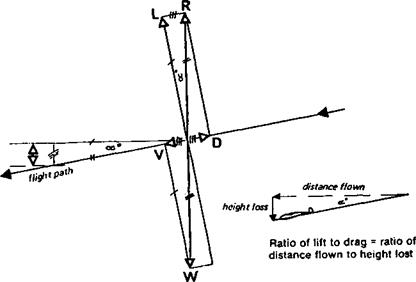SPEED MODELS AND RACERS
To increase the maximum speed of a racer in level flight, it is easily found from Figure 1.4 ;foat either an increase in thrust or a decrease in drag will cause acceleration. Thrust is a «batter of engine tuning and correct choice of propeller. To cut drag, the model must be *18eaned up’, i. e., the total coefficient of drag, Cd. must be reduced. After the leration, when equilibrium is restored, drag force will be once again equal to thrust, since this has been achieved by reducing Cd. the drag equation balances at a higher, as required. The lift force also depends on speed of flight (Fig. 2.1). To balance the equation at the new, higher speed, assuming the ‘cleaning up’ process has not involved у change of wing area or weight, the lift coefficient, Cl, must be reduced. The wing t be trimmed at a lower angle of attack. This re-trimming alone will reduce the vortex
|
Fig. 4.1 The lift to drag ratio of a gliding model
|
induced drag. A reduction of parasite drag of a speed model carries a bonus in the form of, this reduction in induced drag after re-trimming. Also, re-trimming to another angle of attack changes the profile drag of the wing. It may or may not decrease it; this depends almost entirely on the choice of aerofoil section, especially on its camber and its thickness form.
If the minimum weight of the model is not controlled by contest rules, a lighter model requires less total lift force for level flight at any speed. Ibis means that a lighter racing model will fly at a lower angle of attack than a heavy one of identical size and shape. This will cut induced drag, and, as before, may cut profile drag, depending on the aerofoil. A light, clean, model, with appropriate aerofoil, will fly faster.












